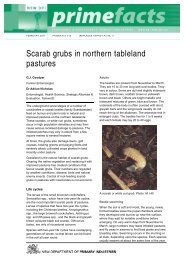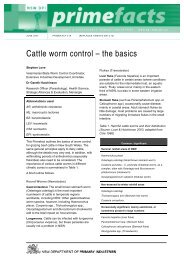cheesy gland - NSW Department of Primary Industries
cheesy gland - NSW Department of Primary Industries
cheesy gland - NSW Department of Primary Industries
Create successful ePaper yourself
Turn your PDF publications into a flip-book with our unique Google optimized e-Paper software.
AGFACTS<br />
AGFACTS<br />
AGFACTS<br />
www.agric.nsw.gov.au<br />
Caseous lymphadenitis (CLA) is a recurring bacterial<br />
disease in goats that causes abscesses in lymph nodes<br />
in internal organs and under the skin.<br />
It is the cause <strong>of</strong> extensive loss through carcase<br />
condemnation in sheep and, as the goat meat industry<br />
increases, a similar substantial loss is likely in the goat<br />
industry.<br />
CAUSE<br />
Cheesy <strong>gland</strong> is caused by infection with the<br />
bacterium Corynebacterium pseudotuberculosis. The<br />
organism occurs in abscesses as well as in the gut and<br />
faeces <strong>of</strong> the goat. It can survive for up to 4 months<br />
on the ground and on fences, feed troughs and head<br />
bails depending on shelter from wind and sun.<br />
SPREAD OF INFECTION<br />
The bacteria are abundant in the pus inside abscesses.<br />
When these abscesses burst, the pus containing<br />
bacteria is transferred to the environment around the<br />
goat pens. The infection is then picked up by other<br />
goats through contamination <strong>of</strong> wounds and broken<br />
skin.<br />
The common behavioral habit amongst goats <strong>of</strong><br />
frequent licking, as well as <strong>of</strong> rubbing their heads and<br />
necks against fence posts and sheds, allows the rapid<br />
spread <strong>of</strong> <strong>cheesy</strong> <strong>gland</strong>. Where goats are kept in<br />
small yards, the direct contact and close grazing <strong>of</strong><br />
contaminated grass or feeds in feed troughs also<br />
encourages spread.<br />
Dairy goats that are placed in head bails for milking<br />
are particularly prone to being infected through<br />
splinters around the neck.<br />
Goat health—<br />
caseous<br />
lymphadenitis<br />
(<strong>cheesy</strong> <strong>gland</strong>)<br />
Agfact A7.9.8, second edition 2004<br />
Robert North<br />
Former Veterinary Officer, <strong>NSW</strong> Agriculture<br />
(Reviewed JT Seaman<br />
Program Leader Flock Health)<br />
Superficial lymph nodes (<strong>gland</strong>s) where caseous<br />
lymphadenitis abscesses commonly occur.<br />
Contaminated grooming gear can spread the bacteria<br />
to other goats. Contaminated shearing blades are an<br />
important method <strong>of</strong> spread in Angoras and<br />
Cashmere goats.<br />
Once the bacteria enter the goat’s body, they spread in<br />
the bloodstream until they become localized in the<br />
lymph nodes, organs or subcutaneous tissue.<br />
SIGNS<br />
Infected lymph nodes grow to become large abscesses<br />
ranging in size from an egg to a grapefruit. The<br />
contents are thick green/yellow cheese-like pus, hence<br />
the common name ‘<strong>cheesy</strong> <strong>gland</strong>’.<br />
ORDER NO. A7.9.8 AGDEX 470/653
Cheesy <strong>gland</strong> is more noticeable in dairy goats<br />
because infected <strong>gland</strong>s are not hidden under<br />
the fleece. Photos: Douglas H. Burrell, Principal<br />
Research Scientist, CSIRO.<br />
In short-haired dairy goats these swollen <strong>gland</strong>s are<br />
obvious, particularly in the head (parotid and<br />
submandibular) and neck, in front <strong>of</strong> the shoulder<br />
(prescapular), in the flank (prefemoral) and udder<br />
(supramammary) lymph nodes.<br />
Abscesses that develop in the internal lymph nodes<br />
present different problems.<br />
Abscesses in the lungs, liver and spleen may cause<br />
illthrift in the goat, making it lose condition or show<br />
other signs such as a chronic cough or loss <strong>of</strong> milk<br />
production. Severely affected goats may die or have to<br />
be put down because <strong>of</strong> debility.<br />
Other abscesses occur in goats due to infection <strong>of</strong> a<br />
local wound.<br />
Examples are vaccination sites after using<br />
contaminated needles, grass seed and thistle spines<br />
causing abscesses around the mouth and lips, and<br />
pustules (especially on the udder) which become<br />
infected with bacteria such as Staphyloccocus spp. and<br />
develop into larger abscesses. These are not necessarily<br />
<strong>cheesy</strong> <strong>gland</strong>; however, treatment in individual goats is<br />
the same.<br />
TREATMENT<br />
In individual goats with large abscesses, lance the<br />
abscess at the lowest point. Flush out the cavity with<br />
disinfectant after the pus has drained. Because pus is<br />
the main method <strong>of</strong> spread, it should be collected and<br />
disposed <strong>of</strong> safely by burying or treating with<br />
disinfectant.<br />
2<br />
Once the cavity is clean, infuse with antibiotic cream<br />
or ointment to assist recovery. Tubes such as those<br />
used for mastitis treatment are very suitable.<br />
STOPPING THE SPREAD<br />
• Isolate infected goats with discharging abscesses<br />
until satisfactorily treated.<br />
• Treat infected goats promptly.<br />
• Try to limit possible wounding <strong>of</strong> goats around the<br />
head and neck from head bails or fences with<br />
protruding nails, wire or splinters.<br />
• Disinfect shearing equipment after use on infected<br />
goats.<br />
PREVENTION<br />
A vaccine is now available for the effective control <strong>of</strong><br />
<strong>cheesy</strong> <strong>gland</strong> in goats. Glanvac 3, Glanvac 6 and<br />
Glanvac 6, B12 are registered vaccines for goats. Kids<br />
should be vaccinated at 6 to 8 weeks <strong>of</strong> age to prime<br />
their immune dose.<br />
Revaccination 4 to 6 weeks after the first dose is<br />
necessary to ensure immunity. Cheesy <strong>gland</strong> vaccine<br />
also contains other clostidial disease vaccines.<br />
PERSONAL HYGIENE<br />
After handling goats infected with <strong>cheesy</strong> <strong>gland</strong>,<br />
ensure you take personal hygiene measures, especially<br />
if you have cuts and abrasions on your hands or arms.<br />
These wounds can become infected, involving lymph<br />
nodes, which in turn become tender and swollen.
There may be some general malaise, fatigue and fever.<br />
Seek prompt medical attention if these signs occur.<br />
FURTHER INFORMATION<br />
For further information, contact your RLPB<br />
veterinary inspector or veterinary practitioner or the<br />
<strong>NSW</strong> <strong>Department</strong> <strong>of</strong> <strong>Primary</strong> <strong>Industries</strong>.<br />
See also Agfact A3.9.21, Cheesy <strong>gland</strong> Caseous<br />
Lymphadenitis in sheep.<br />
Drawing by M. Romer<br />
First edition edited by J. Alice H<strong>of</strong>ler<br />
Division <strong>of</strong> Agricultural Services<br />
ISSN 0725-7759 Job No. 5085<br />
3<br />
DISCLAIMER<br />
The information contained in this publication is based on<br />
knowledge and understanding at the time <strong>of</strong> review August<br />
2004. However, because <strong>of</strong> advances in knowledge, users<br />
are reminded <strong>of</strong> the need to ensure that information upon<br />
which they rely is up to date and to check currency <strong>of</strong> the<br />
information with the appropriate <strong>of</strong>ficer <strong>of</strong> the <strong>NSW</strong><br />
<strong>Department</strong> <strong>of</strong> <strong>Primary</strong> <strong>Industries</strong> or the user’s independent<br />
adviser.<br />
ALWAYS READ THE LABEL<br />
Users <strong>of</strong> agricultural chemical products must always read the<br />
label and strictly comply with directions on the label. Users<br />
are not absolved from compliance with the directions on the<br />
label by reason <strong>of</strong> any statement made, or omitted to be<br />
made, in this publication.

















